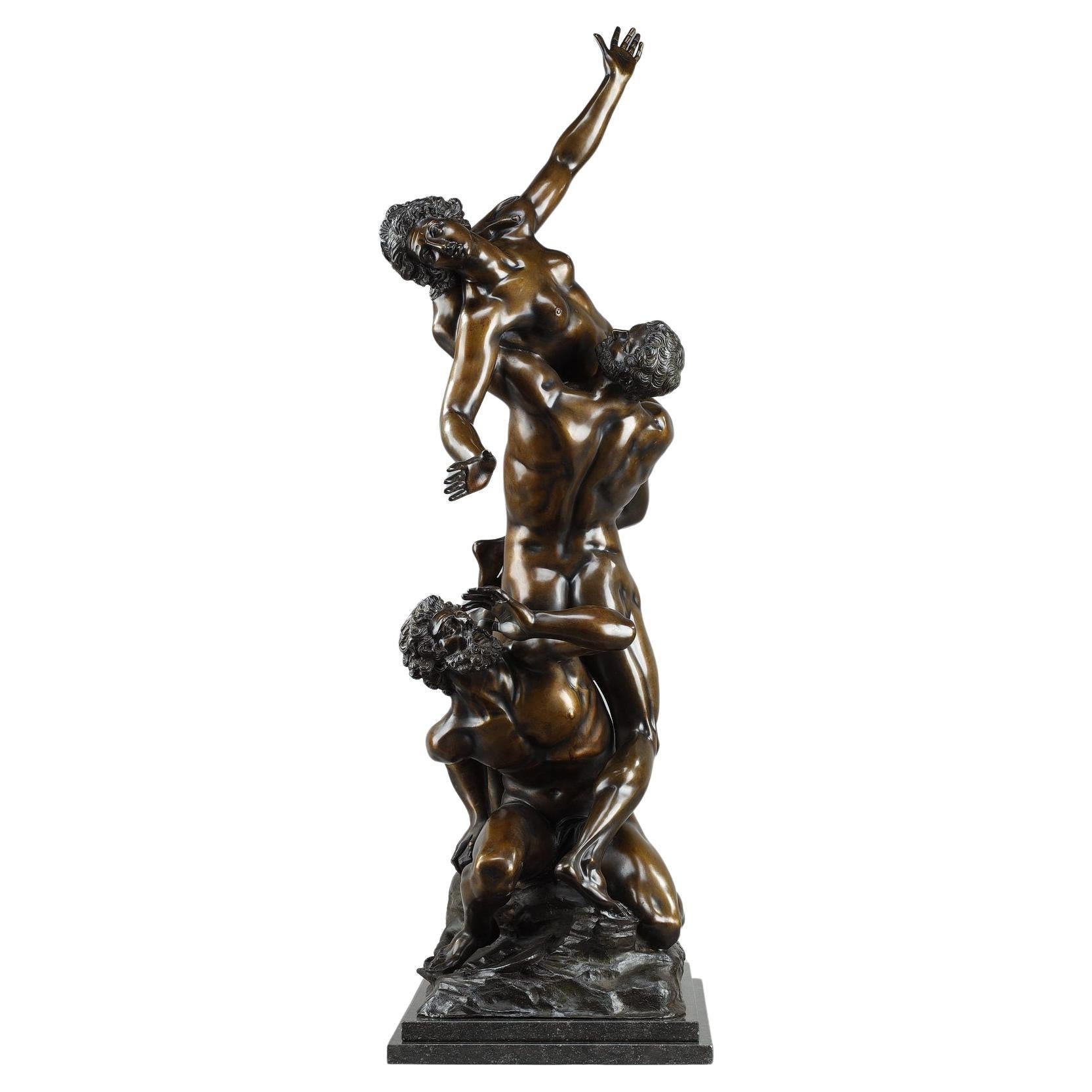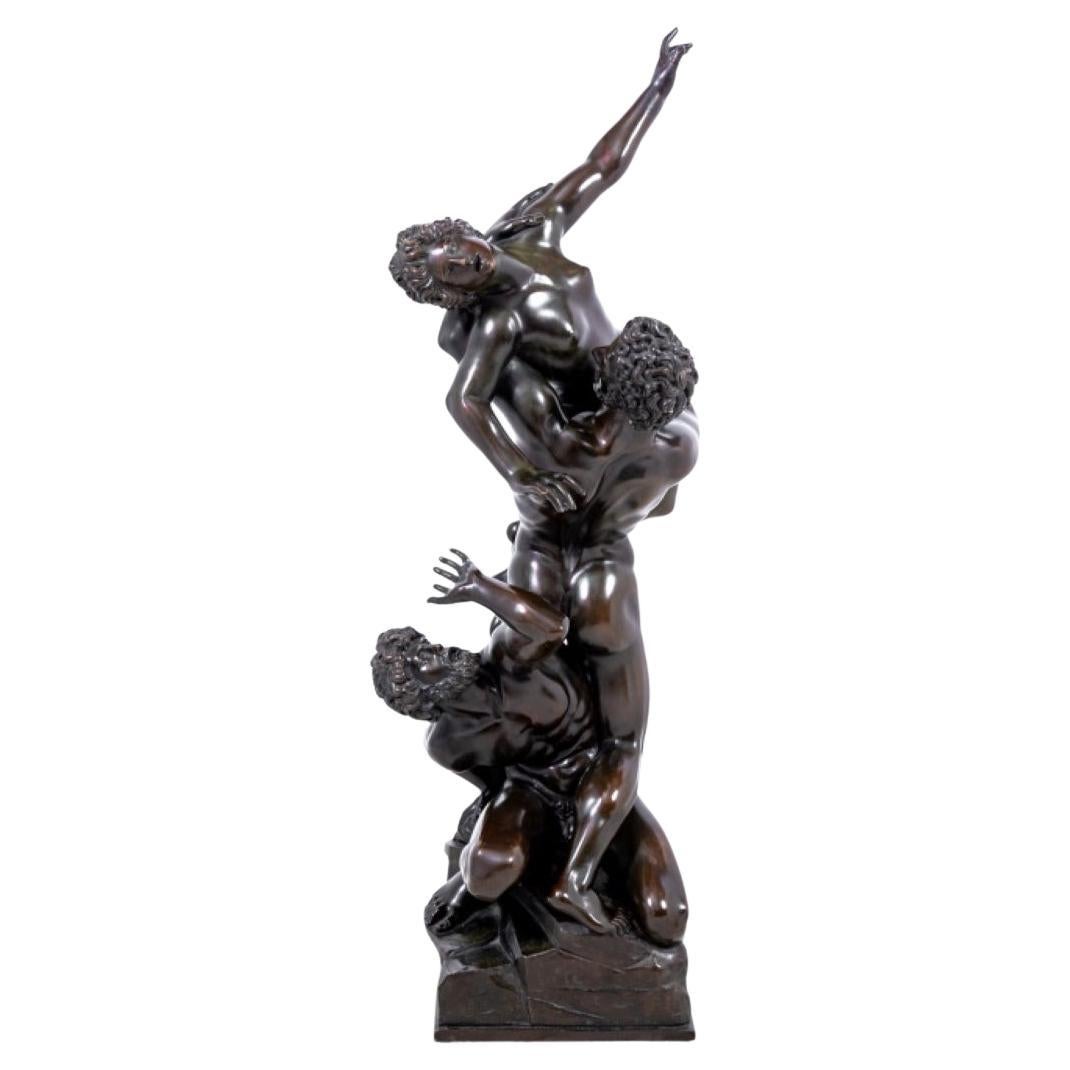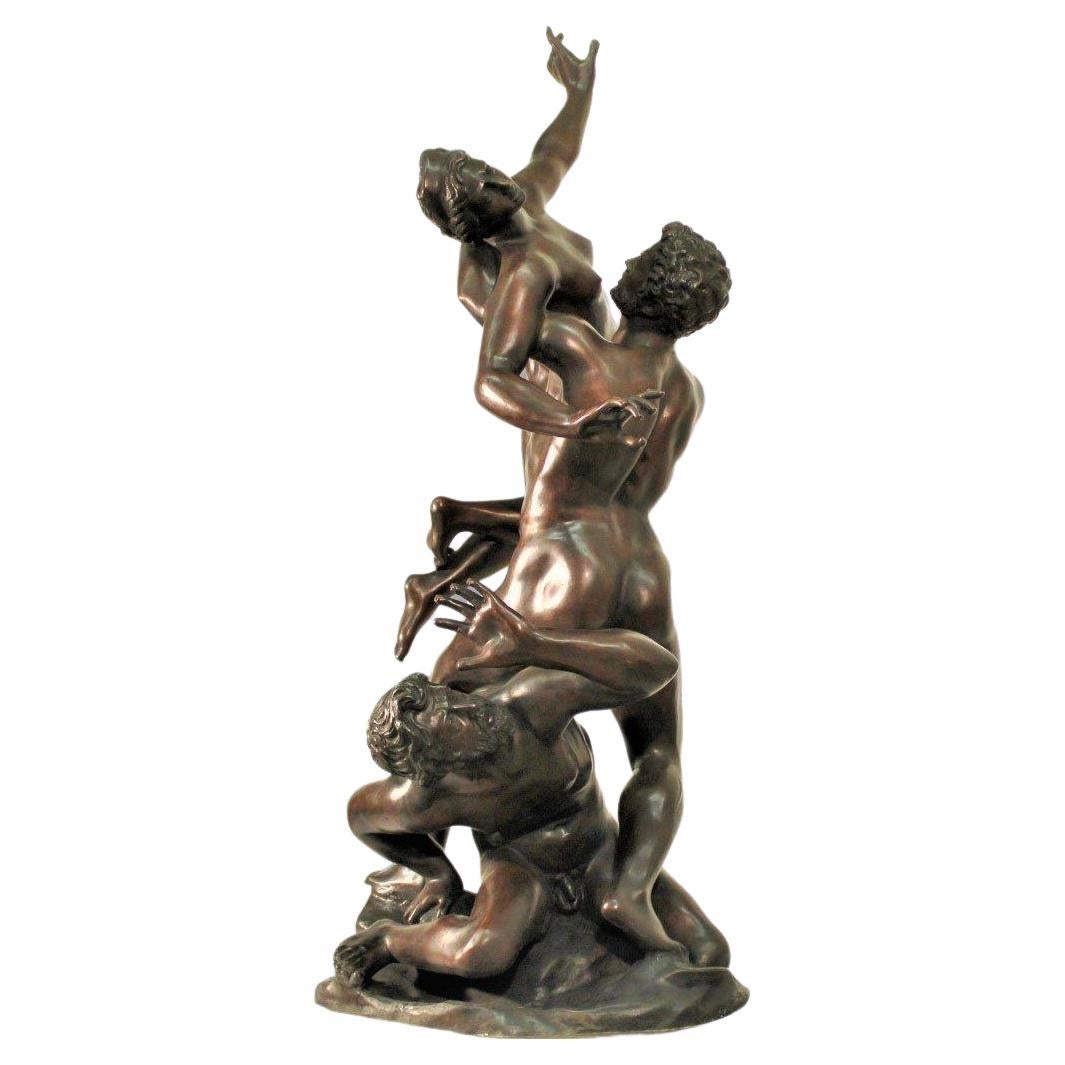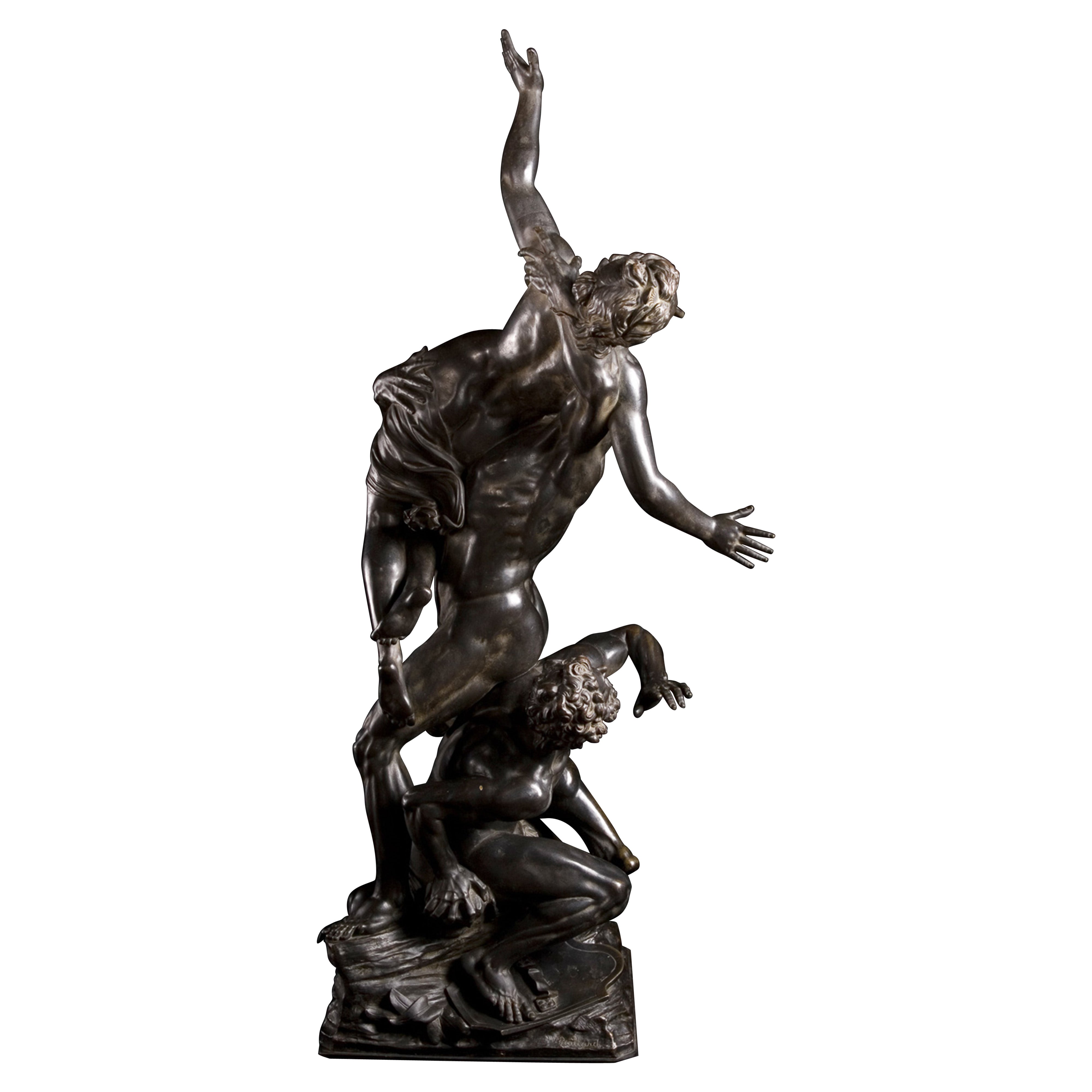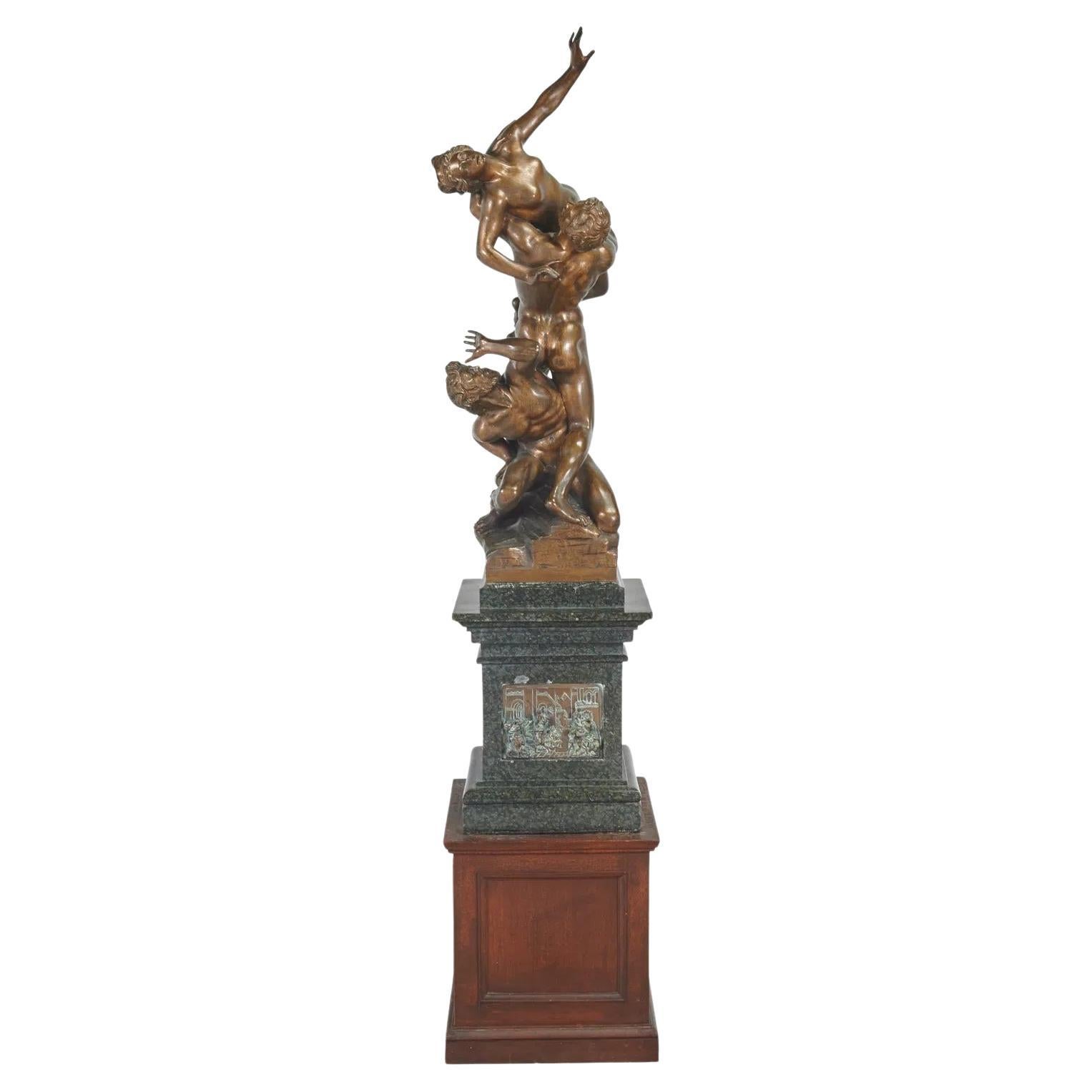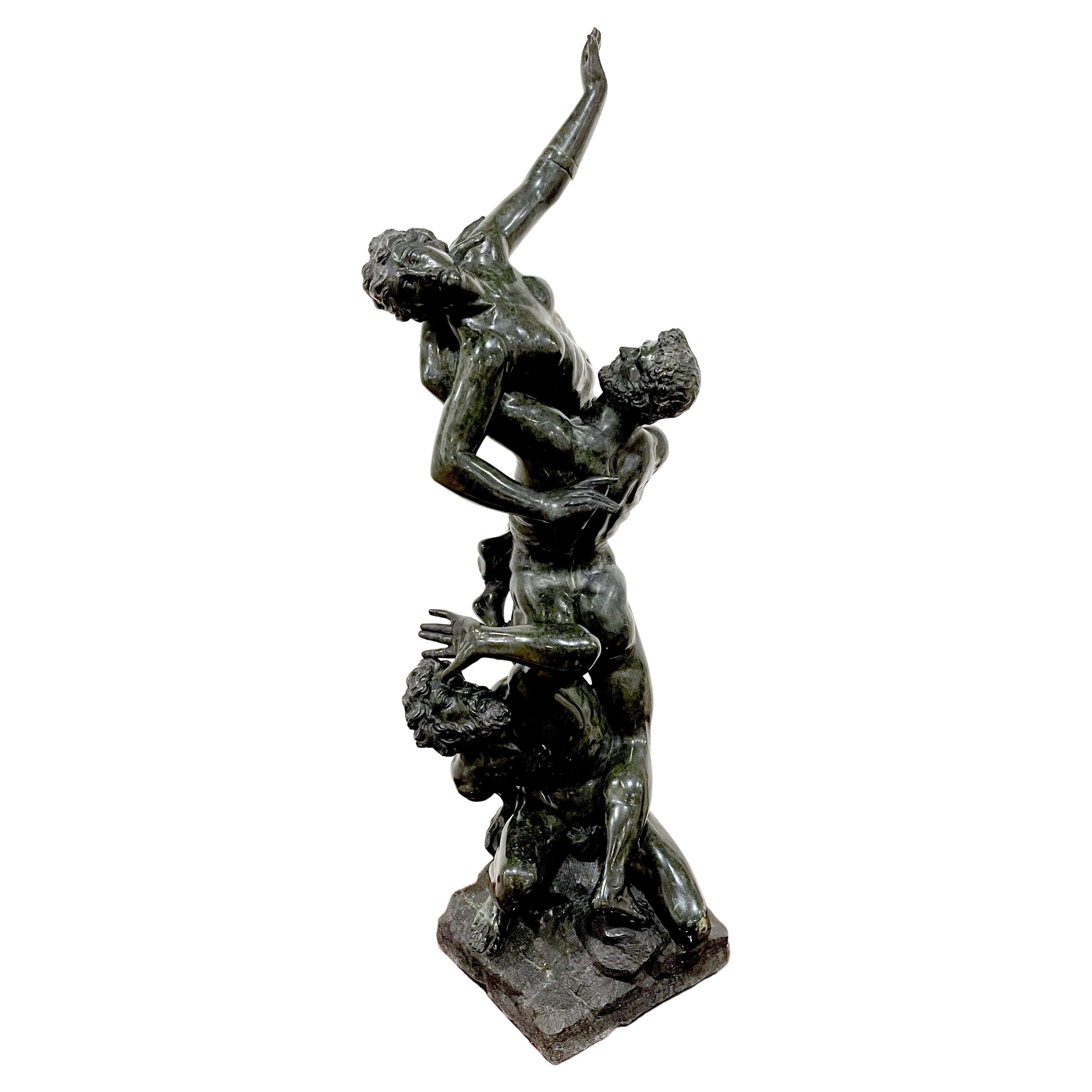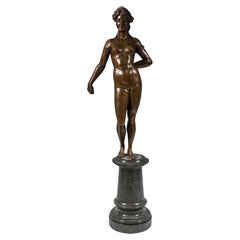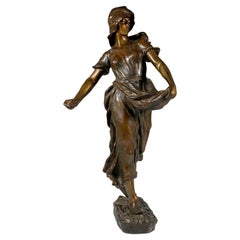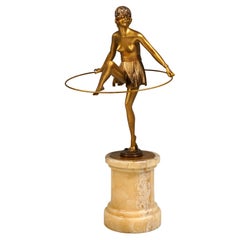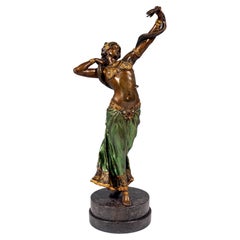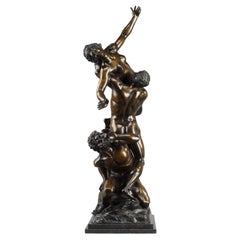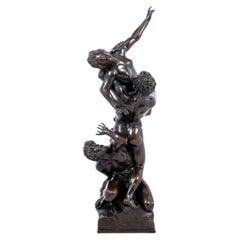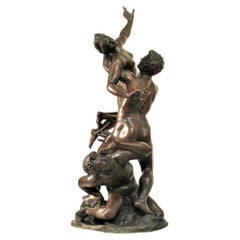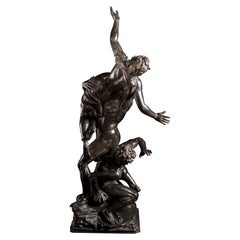Items Similar to 'Rape Of A Woman', Large Bronze Group After Giambologna, Early 20th Century
Want more images or videos?
Request additional images or videos from the seller
1 of 8
'Rape Of A Woman', Large Bronze Group After Giambologna, Early 20th Century
$8,111.80
£5,997.16
€6,800
CA$11,157.65
A$12,402.43
CHF 6,501.09
MX$151,463.63
NOK 81,162.31
SEK 76,358.59
DKK 51,768.29
About the Item
In reference to the remarkaple marble group of three larger-than-life figures, known as ‘The Rape of the Sabine Women’, which is located under the right arcade of the Loggia dei Lanzi in Piazza della Signoria in Florence, Giambologna created a smaller bronze version for the Duke of Parma, Ottavio Farnese, at the same time, in 1579.
This is now in Naples, in the Museo di Capodimonte, and serves as the template for our model.
The defeated Sabine is no longer depicted here, while the victorious Roman has been given a flowing drape that gives the group dynamism and direction and further emphasises the expansive stride. Furthermore, our model is supported by a tree trunk and stands on an oval plinth on an oval, dark flamed marble base.
‘Giambologna may well have been the first artist of the modern era to pursue art for art's sake and for the sake of its perfection’ (Beaucamp 1978). He was not concerned with a message, but solely with moving and moving beauty. It is fair to describe Giambologna's group of figures as the pinnacle of Mannerist sculpture, because it is ‘equally beautiful from all sides’, that is, there is no main view. Around the middle of the 16th century, theoretical discussions
repeatedly demanded that a perfect sculptural work of art must have numerous equally valid perspectives. Furthermore, Giambologna's Rape of the Sabine Woman is the perfect realisation of the figura serpentinata. The figura serpentinata is a figure moving fluidly upwards with a twisted body axis – whereby this twist need not be
based on the action. For the Mannerist sculptor, beauty is ‘no longer static, but dynamic. A beautiful body is still a
well-proportioned body. But the emphasis is no longer on the proportion, but on the elegance of the movement’ (Moser 2006).
syndrome-de-stendhal blogspot - Beautiful from all sides
Beaucamp, Eduard: The Anti-Michelangelo. The artistic world of figures by Giambologna. In: F.A.Z. of 23 December 1978;
Moser, Claus: Giambologna. Web
Design: After Giambologna (1529 - 1608)
Giovanni da Bologna, actually Jean de Boulogne, called Giambologna, was a Flemish-Italian sculptor of the Florentine school of Mannerism and Early Baroque. He came from the County of Flanders, which was ruled by the House of Habsburg and extended far into present-day France, but was mainly active in Italy. His work can be assigned to Mannerism, a form of the Late Renaissance. Giovanni Bologna created numerous sculptures and figures for fountains for the Italian nobility, especially for the Medici. One of his students was the South German and Tyrolean sculptor Hans Reichle.
Manufactured first half of 20th century
Bronze modeling and casting, natural old patina, marble base
Dimensions:
Height: 73,5 cm / 28.93 in
Width: 30,0 cm / 11.81 in
Depth: 24,0 cm / 9.44 in
Weight: 24.240 grams / 853.24 oz / 779.42 troy oz
Very well maintained - natural old patina, signs of age and wear on the marble base
- Creator:Giambologna (Designer)
- Dimensions:Height: 28.94 in (73.5 cm)Width: 11.82 in (30 cm)Depth: 9.45 in (24 cm)
- Style:Renaissance (In the Style Of)
- Materials and Techniques:
- Place of Origin:
- Period:
- Date of Manufacture:20th Century
- Condition:
- Seller Location:Vienna, AT
- Reference Number:1stDibs: LU1014443629962
About the Seller
5.0
Gold Seller
Premium sellers maintaining a 4.3+ rating and 24-hour response times
Established in 1988
1stDibs seller since 2013
305 sales on 1stDibs
Typical response time: 3 hours
- ShippingRetrieving quote...Shipping from: Vienna, Austria
- Return Policy
Authenticity Guarantee
In the unlikely event there’s an issue with an item’s authenticity, contact us within 1 year for a full refund. DetailsMoney-Back Guarantee
If your item is not as described, is damaged in transit, or does not arrive, contact us within 7 days for a full refund. Details24-Hour Cancellation
You have a 24-hour grace period in which to reconsider your purchase, with no questions asked.Vetted Professional Sellers
Our world-class sellers must adhere to strict standards for service and quality, maintaining the integrity of our listings.Price-Match Guarantee
If you find that a seller listed the same item for a lower price elsewhere, we’ll match it.Trusted Global Delivery
Our best-in-class carrier network provides specialized shipping options worldwide, including custom delivery.More From This Seller
View AllLarge Art Nouveau Bronze Figure, Nude On Marble Pedestal, Vienna Ca 1900
By Viennese Manufactory
Located in Vienna, AT
Naked Art Nouveau beauty, her hair artfully tied in a knot and falling on her neck, set with a diadem and adorned with a snake-print bracelet on her upper ar...
Category
Antique Early 1900s Austrian Art Nouveau Figurative Sculptures
Materials
Marble, Bronze
'La Sémeuse', Large Art Nouveau Bronze Figure After Oscar Roty, Vienna, Ca 1899
By Hans Schörk
Located in Vienna, AT
A young woman in a long dress with short sleeves, softly enveloping her body, with a scarf covering her hair and falling well over her face to protect her from the burning sun, walking across the field at a leisurely pace, holding out her apron with the seeds spread out in front of her with her left hand and making a sweeping gesture with her right.
On a narrow, elongated natural plinth with rounded corners, with the artist's signature ‘Schork 99’ incised on the side, as well as the Goldscheider manufactory's pressed stamp, pressed model number and incised monogram ‘AH’ on the back behind the figure.
This motif is particularly well known in France, where it adorned all French franc coins and postage stamps for many years and was continued in a stylised form on all cent coins of the euro after 2001.
Louis Oscar Roty (1846 - 1911) This sower is very familiar to the French: she was depicted on the fifty-centime coin and on the one-, two- and five-franc coins until 2001, when a stylised version of her appeared on the ten-, twenty- and fifty-centime coins of the euro. The figure dates back to 1887, when Roty designed a prize medal for the Ministry of Agriculture, a project that was not pursued. When the Minister of Finance commissioned new coins in 1896, Roty was among the selected artists. He drew on the Sower of 1887, but transformed his robust farmer into a slender Marianne, who wore the Phrygian cap of freedom. The traditional profile of the Republic was abandoned in favour of a more active, standing figure. This effigy was criticised, but generally very well received: ‘The seeds she generously throws into the earth are the countless ideas that may one day germinate and flourish when we are no longer here’ (La Liberté, 8 October 1898). The gesture is more symbolic than realistic – we do not sow against the wind, which nevertheless makes the hair behind the sower flutter – but it makes the composition more dynamic. Originally, ‘The Sower’ was used on the fifty-centime to two-franc coins introduced in 1897 and 1898, before appearing on postage stamps in 1903. It is thus the most widely circulated work of art in France. Although not included in the Musée d'Orsay's medal collection, this wax drawing on slate, typical of the technique of a medallist, is one of the most beautiful pieces and demonstrates the virtuosity of Roty. (Musée d'Orsay, The Collections)
Design by HANS SCHORK...
Category
Antique Early 1900s Austrian Art Nouveau Figurative Sculptures
Materials
Bronze
Bruno Zach Vienna Bronze Austria Semi-Nude Lady with Hoop Bergmann circa 1930
By Bruno Zach
Located in Vienna, AT
Interesting Vienna bronze figurine: Semi-nude lady holding a hoop
It is a finest figurine. The bare-breasted lady stands on round flat bronze base which is attached to column made ...
Category
Vintage 1920s Austrian Art Deco Figurative Sculptures
Materials
Bronze
Viennese Bronze, Snake Dancer on Marble Base, by Franz Bergmann, Around 1910
By Franz Bergmann
Located in Vienna, AT
Young dancer in an oriental costume with a tight bustier, a long, softly falling green skirt and a diadem on her hair tied at the nape of her neck, posing with her upper body stretch...
Category
Vintage 1910s Austrian Art Deco Figurative Sculptures
Materials
Bronze
Vienna Bergmann Bronze Lady Dancer Bruno Zach Made circa 1925-1930
By Bruno Zach
Located in Vienna, AT
Interesting Vienna Bronze Figurine: Dancing Lady
It is a finest figurine - it is a Viennese bronze item.
The lady dancer standing on square carpet balances on her left leg whereas right leg is raised. She is clad in short dancing dress with spaghetti straps, both arms are raised. Woman's head is covered with very special headwear. - This bronze figurine is of stunning liveliness (excellent manufacturing quality) !
Signed:
Letters 'B.Zach' existing (visible on carpet - next to figurine's left foot, at backside).
It is a Viennese Bronze, most probably manufactured by Bergmann Firm, but related signature isn't visible here since the figurine is attached to black & square marble base / signature of Vienna Bronze Bergmann...
Category
Vintage 1920s Austrian Other Figurative Sculptures
Materials
Bronze
'French Dancer', Large Art Déco Bronze Figure, by Carl Binder, France, Ca. 1920
By Carl Binder
Located in Vienna, AT
The pretty dancer has short curly hair held back by a feather tiara, a skimpy bustier, her upper arms adorned with bangles and a skirt held in place by a pearl-studded belt that fall...
Category
Vintage 1910s French Art Deco Figurative Sculptures
Materials
Marble, Bronze
You May Also Like
Very Large Bronze "Abduction of a Sabine Woman" After Giambologna, 19th Cent
By Giambologna, Ferdinando de Luca
Located in Paris, FR
Very large bronze sculpture with brown patina, based on the group "The Rape of the Sabine Women" by John of Bologna (Giambologna). This pivoting composition shows three figures in motion: a man on the ground defeated with his shield turned upside down, a second one arched clutching a woman launched towards the sky trying to escape, all on a naturalistic base. The Sabine man, the Roman and the Sabine woman are all depicted naked. This staging plays on serpentine lines known as "figura serpentinata" and diagonals giving a beautiful variety of volumes and a multiplicity of angles of view. The bronze is signed F. De Luca...
Category
Antique 1880s French Baroque Figurative Sculptures
Materials
Bronze
Giambologna "Rape of the Sabine Woman" Bronze
By Jean de Bologne
Located in Astoria, NY
After Giambologna (Jean de Boulogne, Italian, 1529-1608) "Rape of the Sabine Woman" Patinated Bronze Sculpture, French, late 19th century. 42.5" H x 12" W x 12" D. Note: This bronze ...
Category
Antique 19th Century Figurative Sculptures
Materials
Bronze
After Giambologna, the Rape of the Sabine Women
Located in Rome, IT
Sculpture, large sculptural group "The rape of the Sabine women".
Category
Vintage 1980s Italian Busts
Materials
Bronze
$11,451 Sale Price
20% Off
French 19th Century Paillard Bronze, ‘Abduction of A Sabine Woman' Signed
Located in New Orleans, LA
Gorgeous French 19th century bronze study of the Flemish sculptor and architect Giambologna's "Abduction of A Sabine Woman" signed V. Paillard. Victor Paillard, a 19th century bronzi...
Category
Antique 19th Century French Figurative Sculptures
Materials
Bronze
$45,000 Sale Price
25% Off
Bronze Statue of Abduction of the Sabine Woman After Giambologna
By Giambologna
Located in New York, NY
A fine casting of the Abduction of the Sabine Woman after Giambologna (1529-1608), mounted on marble pedestal with bronze relief of the same subject matter, placed on wooden pedestal...
Category
Antique Late 19th Century Neoclassical Figurative Sculptures
Materials
Bronze
Grand Tour Verdigris Marble After Giambologna, The Abduction of a Sabine Woman'
By Giambologna, Benedetto Boschetti
Located in West Palm Beach, FL
Grand Tour Verdigris Marble After Giambologna, The Abduction of a Sabine Woman'
Italy, Mid- 19th century, Attributed to the workshops of Benedetto Bosch...
Category
Antique Mid-19th Century Italian Renaissance Figurative Sculptures
Materials
Marble
More Ways To Browse
Bronze Tree Of Life
Fountain Woman
Cast Bronze Fountain
Tree Stand German
Dark Web
Signed Moser
Tyrolean Furniture
Sabine Women
Early Capodimonte
Rape Of The Sabine
Giovanni Bologna
Capodimonte Figure
Capodimonte Figural Group
Woman Ceramic Figurine
Alexandre Falguiere
Antique Smelter
Egyptian Horus
F B Decorative Arts
